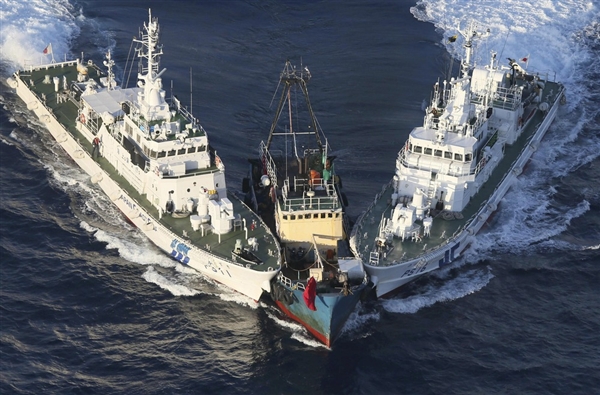
Maritime security in Southeast Asia has recently become one of the foremost areas of geopolitical intrigue and is the breeding ground for several issues that could be potentially explosive in the region.
As always, economics and resources play a big factor– recent discovery of enormous gas and oil reserves in the South China Sea has piqued the interest of all the regional players in a body of water already vitally important for its shipping routes.
When you throw in century-long tensions and an unhealthy dose of nationalism, the escalating situation appears alarming to the United States, who serves as a guarantor of peace and stability in the region.
Recent developments have brought activists landing on disputed islands, re-ignited maritime border disputes and even threats of military action.
The disputes seem limitless: The South China Sea, known as the West Philippine Sea to the Philippines, has had multiple countries claiming sovereignty for over half a century. U.S. Secretary of State Hilary Clinton, in a speech made to the Association of Southeast Asian Nations (ASEAN), asserted that maritime security was one of the U.S. primary focuses in the region.
Recently, China has sent military units to patrol the South China Sea, with an emphasis on enforcing control of disputed areas. While this move has been criticized by many other nations, the more dangerous confrontation is occurring between China and Japan.
Oil-inhabited Islands
While there has been squabbling over maritime claims for decades, the most recent escalating face off has occurred between China and Japan. Both countries have asserted claims to the Senkaku Islands as they are known by the Japanese, or the Diaoyu islands as they are known by the Chinese.
Technically, three entities have laid claim– China, Japan and Taiwan. This complicates the situation even further– China and Taiwan, despite a complicated relationship themselves, both agree that the islands are part of Taiwan. However, Japan disagrees entirely, claiming the island for their own. It also doesn’t even recognize Taiwan as a sovereign state, but rather part of a province of China.
Of course, the supposedly vast oil reserves near Senkaku lie at the heart of the insistent claims for these tiny, uninhabited islands. The dispute has also roused century old nationalist tensions between Japan and China, driving nationalist activists from both countries to land on the islands in an effort to assert control.
Additionally, the United States has deemed Japan’s claim legitimate, which is expected– the two countries are close allies, and the United States was the last country to control the islands before Japan– they were transferred back to Japan after the end of World War II.
Because of this relationship, the United States is obligated to defend the islands from any kind of military action, drawing the country directly into the dispute. Fortunately, the might of the United States military serves as an overall deterrent to China, which would be unlikely to intentionally initiate a conflict that would be difficult to win.
Guiding the conflict to a peaceful détente is the only acceptable option for the United States. The more militarized and instable they allow the region to become, the more other countries will feel the need to militarize for themselves, potentially creating a catastrophic drive toward war. If smaller nations such as the Philippines doubt the ability of the United States to enforce peace, they may either bend to China’s will, or feel the need to take militarization into their own hands.
Chinese/Japanese relations have been tense since Japan’s violent invasion of the mainland in the 1930’s and the brutal fighting of World War II in the Pacific. As moderates have been recently scorned in China, this increasingly radicalized nationalism is a primary factor escalating this conflict.
You say South China, I say West Philippine
The most militarily active conflict is actually the one occurring between China and the Philippines for control over the disputed section of the sea they both claim as their own. Although the Philippines has tried quiet diplomacy for years, they have made little progress and are now claiming that military action may be their only option.
Reports have indicated numerous skirmishes between Chinese and Philippine vessels in 2011, but claims remain difficult to substantiate due to the lack of modern surveillance equipment in the area.
Again, this is a very dangerous development as the Philippine government feels the need to further ratchet up its military. This is a real threat to regional security– when tensions and military spending rise in tandem, there is often conflict in the future.
China and Vietnam
The Socialist Republic of Vietnam, despite political similarities and alliances, also has maritime disputes with China. Because the Chinese responded with force when the Paracel Islands were disputed in 1988, many in Vietnam believe that the sleeping giant won’t hesitate to use the military to assert its dominance once again.
According to a report from the International Crisis Group, nationalist fever in Vietnam has also contributed to the problem. Many local Vietnamese are urging their government to stand up to China with military force. However, the Vietnamese are unlikely to provoke a conflict which they cannot win, especially if it means further destabilizing the region.
With so many smaller countries attempting to rebuff China’s regional aggression, a domino effect of resistance is one of the most destabilizing outcomes. If any one smaller country decides to take a stand against China, however ill-advised, it becomes harder for all of the other governments to ignore nationalist war-hawks in their own countries. The United States must use its powerful military and most importantly, disinterested perspective to maintain order in this vital powder keg of a region.